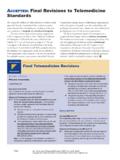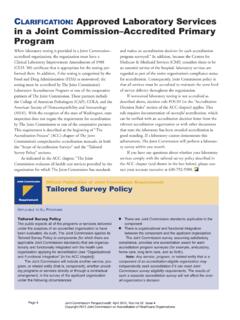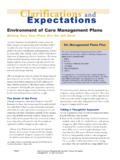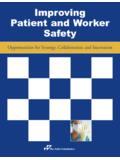Transcription of Crash-cart preparedness - Joint Commission
1 (Cont.) Legal disclaimer: This material is meant as an information piece only; it is not a standard or a Sentinel Event Alert. The intent of Quick Safety is to raise awareness and to be helpful to Joint Commission -accredited organizations. The information in this publication is derived from actual events that occur in health care. The Joint Commission , Division of Health C are Improvement Issue 32 April 2017 Crash-cart preparedness Issue: Take a close look at your organization s crash carts. Are they ready for a life-threatening emergency? Many crash carts (also called emergency carts/bags/boxes) have hidden issues that could contribute to patient safety events. While much of the literature on crash cart-related safety events is about medication errors, this issue of Quick Safety will focus on ensuring that the crash cart is ready for the next life-threatening emergency whether it is happening to a patient, staff member or visitor.
2 In a 12-month data review of 2008, the Pennsylvania Patient Safety Authority identified 56 reports that highlighted emergency or rapid response situations in which supplies or equipment were missing or outdated. Of the 56 reports, 35 referenced issues with crash carts and 21 referenced issues with missing supplies or malfunctioning equipment during an emergency Contributing factors to patient safety events related to crash carts include, but are not limited to: Medication errors and mix-ups Missing, expired, damaged, contaminated, and unavailable equipment or medications Empty oxygen tanks Drained batteries on equipment or equipment failure Unsecured carts or carts that have been tampered with Carts secured with heavy duty tape and/or padlocks, preventing immediate access Incorrect size of equipment Carts not checked or inspected according to policy and procedure Staff is unable to locate the crash cart.
3 Resulting in a delay getting emergency equipment to the bedside Staff is unfamiliar with the items regularly stored within the crash cart Staff is unfamiliar with the procedures for using the crash cart when responding to a life-threatening emergency Staff is unfamiliar with procedures regarding how to stock or restock the crash cart Some of these issues may appear minor, but alone or in combination, they may produce delays in providing care, thereby creating a patient safety risk. By improving the efficiency and reliability of the crash cart, and preventing unnecessary delays, you can improve patient outcomes following a crisis Some innovative strategies implemented at other organizations Below are two examples of electronic solutions that have been successfully implemented to keep crash carts ready for the next emergency; the Safety Actions section provides solutions that are not reliant on technology.
4 One large hospital developed a web-based Crash-cart tracking In addition to replacing paper logs on each crash cart, this system: Enables the nursing management team to remotely track and monitor which department or units in the hospital checked their crash carts. Each month, alerts staff to any item near its expiration date, prompting the appropriate departments to change the medicines and supplies. Sends the management team three notifications daily, beginning at noon, of which carts have and have not been checked. Helps to identify the clinical areas where there are opportunities for improvement. Quick Safety Issue 32, April 2017 Page | 2 Legal disclaimer: This material is meant as an information piece only; it is not a standard or a Sentinel Event Alert.
5 The intent of Quick Safety is to raise awareness and to be helpful to Joint Commission -accredited organizations. The information in this publication is derived from actual events that occur in health care. The Joint Commission , Division of Health C are Improvement Also, in a study conducted in 2014 by the Heart of England NHS Foundation Trust (United Kingdom), three hospitals implemented a sealed tray system and database that improved equipment availability traceability and Most notably, they: Reduced complexity through equipment standardization and simplification of the trolley ( , cart)checking process by reducing cart items that required checking from 108 to 28. Through the sealed tray system, prevented clinicians borrowing emergency equipment and madestorage of surplus equipment design includes three trays: basic airway; advanced airway; and intravenous (IV) access/circulation equipment.
6 Each piece of equipment is scanned by the database system and then placed in the tray. The system logs the equipment placed in the tray, and prints the tray label once all items are present. The tray label seals the tray, and lists the tray s unique identification number, its contents, and the shortest expiry data of tray equipment. Each tray is inserted into a drawer in the resuscitation cart. The database system tracks trays in and out of a central point on each hospital site, and it records item batch numbers and expiry Safety Actions to Consider: Medical emergencies have the tendency to create an uneasiness and a sense of chaos during the event. These feelings may be magnified if the emergency equipment used to rescue the patient is not readily available.
7 The intent of a crash cart is to ensure that the correct emergency equipment, medications and supplies are readily available to manage the Start with a risk assessment: Identify the risk points; drill down to find the issues and where they originated. Risk points can include: Staff training and educational needsoIdentify who responds; ensure that the staff person has appropriate education and training1oIdentify who checks the crash cart and how frequently it is checked ( , daily, once per shift,once during hours of operation) (per policy or written plan)oIdentify who checks emergency equipment (per policy or written plan)1 Location of crash cartsoMaintain the cart in a location that is easily accessible to the clinical areas1oMake sure staff know where and how the cart and/or emergency equipment is stored Contents of the crash cartsoClearly arrange drugs in the medication drawer so that they are easy to locate and the namesare clearly visible (or clearly labeled and visible).
8 3oSegregate and clearly label pediatric medications. Plastic bags can be used to separate thepediatric drugs from other medications. Label the outside of the drawers that house references handy, particularly for medications and proper medication dosages forpediatric emergencies3oDetermine who restocks or replaces emergency equipment and medications in the cartoCreate a process for restocking and replacing the contents of the cartoCommunicate the crash cart restocking and/or replacement process to all applicable clinicalstaffEvaluating and mitigating risk: Monitor or capture data related to specific issues identified as contributing factors to unsafe incidents concerning crash carts and emergency equipment (see list above). The contributing factors can help focus your improvement efforts.
9 As these contributing factors arise, evaluate and analyze the risks independently and collectively to determine the best solution for the issue. Taking action and sustaining improvements: Develop your plan of action, implement it, and continuously reassess, and revise to ensure that yourcrash carts and staff are ready for life-threatening medical a minimum, the written plan addresses equipment, supplies, medications, inventorymanagement, emergency protocols, training and competency of staff, emergency drills and/orQuick Safety Issue 32, April 2017 Page | 3 Legal disclaimer: This material is meant as an information piece only; it is not a standard or a Sentinel Event Alert. The intent of Quick Safety is to raise awareness and to be helpful to Joint Commission -accredited organizations.
10 The information in this publication is derived from actual events that occur in health care. The Joint Commission , Division of Health C are Improvement simulation exercises, and assignment of responsibility for continued oversights of the Determine which items are needed for the specific clinical area and who needs to be involved in theselection process ( , hospital administration, pharmacy, central supply).1 As required, conduct continuing education and training, which can include mock codes and/or crashcart training In many hospitals, the crash cart may be stocked and replenished by another department, such as the pharmacy or central supply. If this is the case, representatives from these areas should be involved in the needs assessment and be included as part of the written Resources: Patient Safety Authority: Clinical Emergency: Are You Ready in Any Setting?















